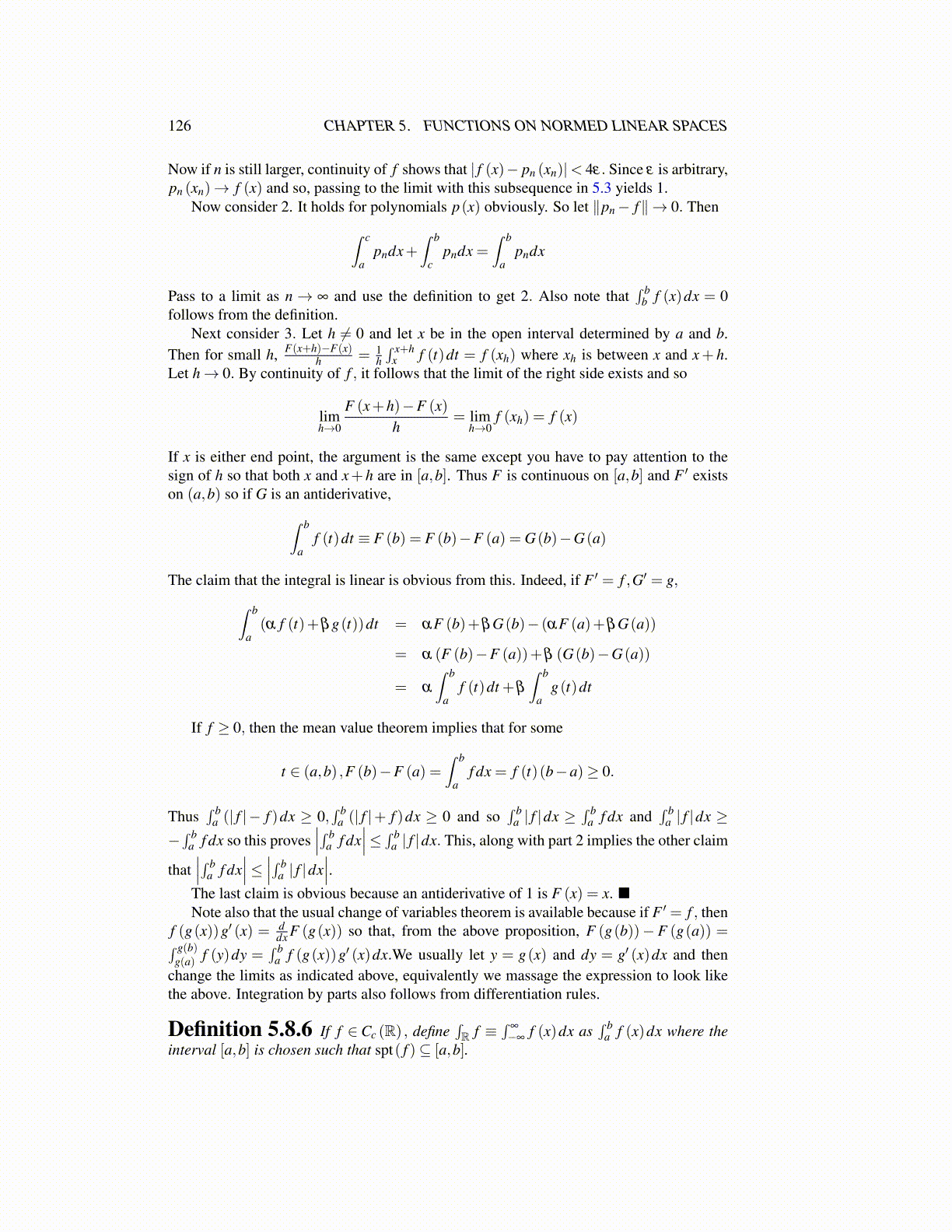
126 CHAPTER 5. FUNCTIONS ON NORMED LINEAR SPACES
Now if n is still larger, continuity of f shows that | f (x)− pn (xn)|< 4ε. Since ε is arbitrary,pn (xn)→ f (x) and so, passing to the limit with this subsequence in 5.3 yields 1.
Now consider 2. It holds for polynomials p(x) obviously. So let ∥pn− f∥→ 0. Then∫ c
apndx+
∫ b
cpndx =
∫ b
apndx
Pass to a limit as n→ ∞ and use the definition to get 2. Also note that∫ b
b f (x)dx = 0follows from the definition.
Next consider 3. Let h ̸= 0 and let x be in the open interval determined by a and b.Then for small h, F(x+h)−F(x)
h = 1h∫ x+h
x f (t)dt = f (xh) where xh is between x and x+ h.Let h→ 0. By continuity of f , it follows that the limit of the right side exists and so
limh→0
F (x+h)−F (x)h
= limh→0
f (xh) = f (x)
If x is either end point, the argument is the same except you have to pay attention to thesign of h so that both x and x+h are in [a,b]. Thus F is continuous on [a,b] and F ′ existson (a,b) so if G is an antiderivative,∫ b
af (t)dt ≡ F (b) = F (b)−F (a) = G(b)−G(a)
The claim that the integral is linear is obvious from this. Indeed, if F ′ = f ,G′ = g,∫ b
a(α f (t)+βg(t))dt = αF (b)+βG(b)− (αF (a)+βG(a))
= α (F (b)−F (a))+β (G(b)−G(a))
= α
∫ b
af (t)dt +β
∫ b
ag(t)dt
If f ≥ 0, then the mean value theorem implies that for some
t ∈ (a,b) ,F (b)−F (a) =∫ b
af dx = f (t)(b−a)≥ 0.
Thus∫ b
a (| f |− f )dx ≥ 0,∫ b
a (| f |+ f )dx ≥ 0 and so∫ b
a | f |dx ≥∫ b
a f dx and∫ b
a | f |dx ≥−∫ b
a f dx so this proves∣∣∣∫ b
a f dx∣∣∣≤ ∫ b
a | f |dx. This, along with part 2 implies the other claim
that∣∣∣∫ b
a f dx∣∣∣≤ ∣∣∣∫ b
a | f |dx∣∣∣.
The last claim is obvious because an antiderivative of 1 is F (x) = x. ■Note also that the usual change of variables theorem is available because if F ′ = f , then
f (g(x))g′ (x) = ddx F (g(x)) so that, from the above proposition, F (g(b))− F (g(a)) =∫ g(b)
g(a) f (y)dy =∫ b
a f (g(x))g′ (x)dx.We usually let y = g(x) and dy = g′ (x)dx and thenchange the limits as indicated above, equivalently we massage the expression to look likethe above. Integration by parts also follows from differentiation rules.
Definition 5.8.6 If f ∈ Cc (R) , define∫R f ≡
∫∞
−∞f (x)dx as
∫ ba f (x)dx where the
interval [a,b] is chosen such that spt( f )⊆ [a,b].